The D. S. Morgan Building 1895-1965: Niagara and Pearl Streets
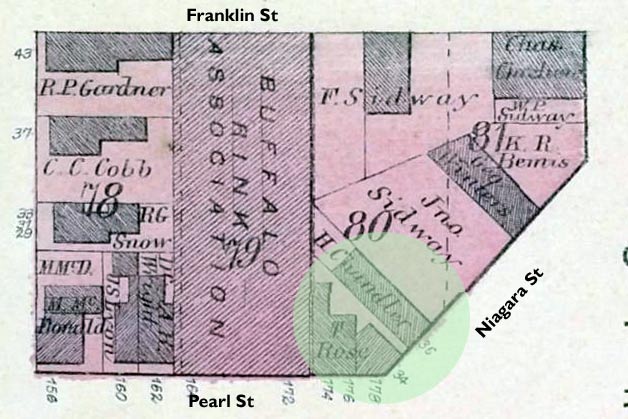
1872 City Atlas, with the corner where the Morgan building would stand circled in green.
Image source: New York Public Library
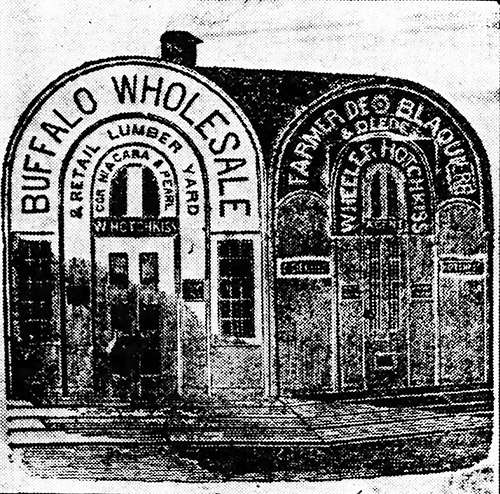 Drawing of the first structure on the corner. Image source: Buffalo Times, May 1909
Drawing of the first structure on the corner. Image source: Buffalo Times, May 1909
In 1907, Buffalo Times feature writer Grace Carew Shelton recalled the first structure at the angled corner of Pearl and Niagara streets. It was "a curious, one-story, oval-shaped, two-entranced construction of timber, one door on Niagara Street and one on Pearl Street. Wheeler Hotchkiss managed a wholesale and retail lumber company on the site in the 1840's, an ideal location for such an enterprise in a growing city.
In 1859, he moved his business. Thomas Rose purchased the land, which previously had been leased, from the Sidway family. (Franklin Sidway had purchased the land at foreclosure in 1821.) Thomas Rose built a brick two-story double house on the land. Mrs. Rose ran a "stylish" millinery business there for some years. In 1888 the property was sold to the D. S. Morgan Company of Brockport. The company had been purchasing parcels at this location and by 1892 had purchased all three necessary parts to construct a modern office building.
The company namesake, D.S. Morgan, died in 1890. His sons, George D. and William P., continued with the project.

1894 City Atlas. The plot at left was utilized by Hart's Gardens, which brought in circuses or 'menageries.'
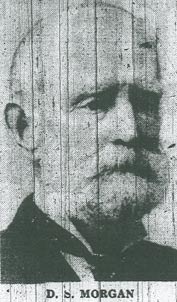 Dayton Samuel Morgan, born in 1819 of a poor, indebted family, began his working career as a clerk in the Brockport office of the Collector for the Erie Canal. His talents impressed a number of prominent local men and in 1846, he partnered with William H. Seymour, Brockport's wealthiest merchant, to begin manufacturing McCormick reapers in Brockport. They called the company, Seymour and Morgan, and produced the reapers at the Globe Iron Works. In 1873, when a completely automatic reaper was perfected, Morgan bought the patent and bought out Seymour's interests. He reorganized the company as the D.S. Morgan Company.
Dayton Samuel Morgan, born in 1819 of a poor, indebted family, began his working career as a clerk in the Brockport office of the Collector for the Erie Canal. His talents impressed a number of prominent local men and in 1846, he partnered with William H. Seymour, Brockport's wealthiest merchant, to begin manufacturing McCormick reapers in Brockport. They called the company, Seymour and Morgan, and produced the reapers at the Globe Iron Works. In 1873, when a completely automatic reaper was perfected, Morgan bought the patent and bought out Seymour's interests. He reorganized the company as the D.S. Morgan Company.
The office building in Buffalo was designed by Green and Wicks. It was said to be the first steel-framed office building in Buffalo; two million pounds of steel were used. Twelve stories high (221 feet), the exterior of the first two stories was granite; the third and fourth were gray brick, and the remainder was terra cotta. Ornamented and embellished on the exterior, the interior featured mosaic, white Italian marble, Tennessee marble, and white oak throughout. Each floor had 4,500 square feet of office space, serviced by four elevators. Construction, begun in 1894, was by the Chicago firm of George E. Fuller. Total cost of construction was $500,000. See the architects' floor plan here.
Morgan's sons had a plaque installed inside the building in honor of their father.
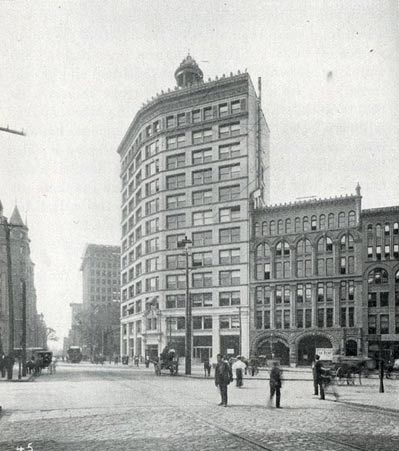
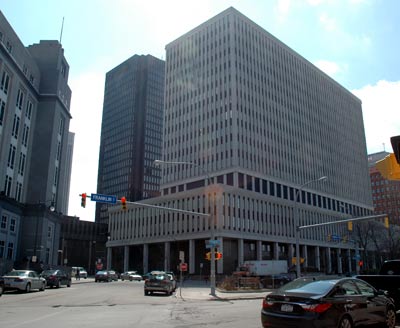


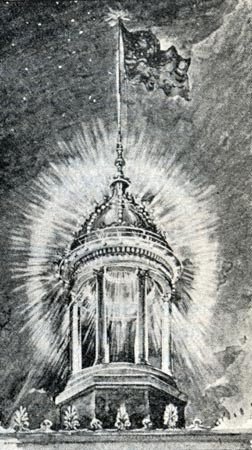 The building also featured an observation tower open to the public from 7 a.m. through 11 p.m. For ten cents, the visitor was at "the highest point in the city from which to view the grandest panorama the eye ever dwelt upon - the entire city at a glance, Lake Erie, the harbor, the beautiful Niagara majestically wending its way... the entire Niagara region, Grand and Navy islands and a goodly portion of Canada, distinctly visible to naked eye on clear days...Fifteen minutes on the Tower will do more to geographically locate any objective point than weeks of walk or ride around the city."["Ins and Outs of Buffalo"]
The building also featured an observation tower open to the public from 7 a.m. through 11 p.m. For ten cents, the visitor was at "the highest point in the city from which to view the grandest panorama the eye ever dwelt upon - the entire city at a glance, Lake Erie, the harbor, the beautiful Niagara majestically wending its way... the entire Niagara region, Grand and Navy islands and a goodly portion of Canada, distinctly visible to naked eye on clear days...Fifteen minutes on the Tower will do more to geographically locate any objective point than weeks of walk or ride around the city."["Ins and Outs of Buffalo"]
To see the view of Buffalo from the tower, look here.
William P. Morgan moved to Buffalo and actively managed the building until his death in 1937. Years later, when the building was about to be demolished, lawyers who had worked in the building recalled the Morgan Building fondly. Attorney Sidney B. Pfeifer said, "The leading lawyers of the city had their offices here when I moved in." Another attorney said that it was the ideal location for lawyers as it was close to County Hall and the courts. He also described a collegial atmosphere in the building where older lawyers helped the younger ones.
From 1948-1954, former Buffalo Mayor Joseph Kelly owned the building. Then a Buffalo group purchased it for $350,000. It had 110 offices at that time. In 1958, a Rochester syndicate paid $500,000 for it, intending to remodel and modernize it with air-conditioning and automatic elevator. It had 140 tenants.
In 1963, the building went in to foreclosure and was purchased by Nelson R. Barrett for $500,000.It was less than 60% occupied. Erie County purchased it in the fall of 1964 for $426,000; it also purchased the vacant Niagara Hotel next door ($94,500) with plans to demolish both for construction of a new county building.
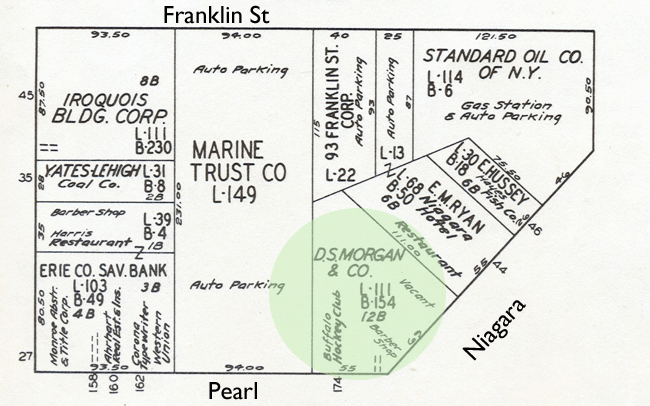
1950s Nierenstein insurance map. Image source: private collection.

Demolition of the Morgan building 1965. Image source: HAER Library of Congress

Photo from Buffalo Evening News, May 26, 1965, of the demolitoin of the Morgan Building. The caption says,"Spared. An ornate piece of masonry bearing a shield and horns of plenty, above what was the entrance to the Morgan Bldg., has been bought by Joseph Tripoli of Kenmore for use over the door of his new home..."

Modern Bing image of the corner. Note that Niagara Street no longer intersects Pearl, the angle having been removed to square the plot on which the Erie County Rath Building stands.